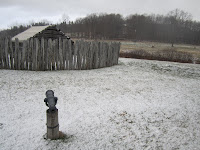
I woke up ready to hit the road and when I opened my door what to my wondering eyes did appear but 2 inches of snow covering my car and a blizzard currently in progress! I was not expecting that. Ever since my barb wire and ice incident almost three years ago exactly I am terrified to drive in the snow so I hit the roads at a crawl. Luckily it was a dry snow so the roads weren’t too terrible. On the way to my first site I came across one of those old barns with tobacco advertising on the side that I thought was cute. 
I love this new setting on my camera which allows you to isolate a color and turn everything else to black and white. It made the Flight 93 pictures from yesterday quite poignant I thought.
Since I was in the mountains of Southwestern PA the roads were quite upsy downsy. That wasn’t a problem as I was the only car out but I soon came upon a truck that was chugging along in first gear up a steep hill (and I am leery of steep snowy hills since I have a standard). I waited at the bottom for a few minutes and when he had made it up I took off and blazed up in second gear. I finally arrived, white-knuckled at Fort Necessity.
Because it was cold and windy I was the only one there for my entire visit. I had no idea how much history happened here! It was amazing to hear and see a battle that I had never before heard of but was integral to the history of America.
The action at Fort Necessity was the first major event in the military career of George Washington, and it marked the only time he ever surrendered to an enemy. Here’s the story:
Rival claims between the French and the English to the vast territory along the Ohio River between the Appalachian Mountains and the Mississippi were what led to the battle. In 1753, the Governor of Virginia learned the French had built a fort in that part of the Ohio country claimed by Virginia. So he sent an eight-man expedition under George Washington to warn the French to withdraw. Washington, then only 21 years old, made the journey in midwinter of 1753-54. The French refusal to withdraw set the stage for the events that took place at Fort Necessity.
In early April, George Washington, newly commissioned lieutenant colonel, started westward from Alexandria with part of a regiment of Virginia frontiersmen to build a road to Redstone Creek on the Monongahela. He was then to help defend the English fort on the Ohio. When told the fort was in French hands, he resolved to push on to Redstone Creek and await further instructions.
Washington arrived at the Great Meadows, as the Fort Necessity area was then called, on May 24. Although the meadow was nearly all marsh, he believed it "a charming field for an encounter" and ordered his men to set up an encampment. Three days later, after hearing that a group of French soldiers had been spotted about seven miles away on Chestnut Ridge, Washington and 40 men set out to find them. At dawn on May 28, the Virginians reached the camp of Tanacharison, a friendly Seneca chief known as the Half King. His scouts then led them to the ravine about two miles to the north where the French were encamped.
The French, commanded by Jumonville, were taken by surprise. Ten were killed, including Jumonville (by Half King). Fearing "we might be attacked by considerable forces," Washington undertook to fortify his position at the Great Meadows. During the last two days of May and the first three days of June, he built a circular palisaded fort, which he called Fort Necessity.
The rest of the Virginia regiment arrived at the Great Meadows on June 9, along with supplies and nine swivel guns. Washington's command now totaled 293 officers and men. He was reinforced several days later by about 100 men. Washington's attempts to retain his Indian allies were not successful.
On the morning of July 3, a force of about 600 French and 100 Indians approached the fort. After the French took up positions in the woods, Washington withdrew his men to the entrenchments. Rain fell throughout the day, flooding the marshy ground. Both sides suffered casualties, but the British losses were greater than French and Indian losses.
The fighting continued sporadically until about 8 p.m. Then Capt. Louis Coulon de Villiers, commander of the French force and brother of Jumonville, requested a truce to discuss the surrender of Washington's command. Near midnight, after several hours of negotiation, the terms were reduced to writing and signed by Washington and Mackay. Because the paper was brought to Washington in the rain it was soggy and smudged and the courier had very little knowledge of French so Washington did not interpret a key phrase correctly and ultimately admitted to the assassination of Jumonville (he did not discover this fact until years later).
This battle helped to set the stage for the French and Indian war and ultimately the American Revolution.










interesting. I am getting so excited for the spring. I need a good road trip!!
ReplyDelete